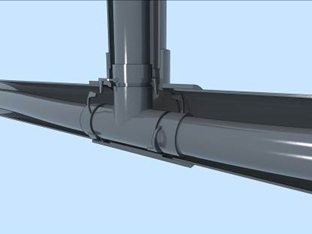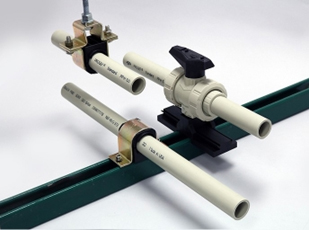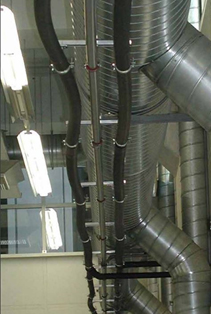5 Key Steps To Better Plastic Piping Designs
Most people understand the inherent benefits of plastic piping — chemical resistance, installation speed, ease of assembly, cost efficiency, longevity in corrosive, harsh exterior or underground environments, etc. Not everyone, however, fully appreciates the nuances of plastic piping design that help to maximize those benefits most efficiently. The perspectives and tips contained in this overview show how key considerations in the design process can smooth the path to successful plastic piping design, installation, and performance in water and wastewater transport, drainage, chemical treatment, and double containment applications.
Vive La Différence
Just as not all metal piping options function the same, so too, polyvinylchloride (PVC) is not polyethylene (HDPE), is not polypropylene (PP), is not polyvinylidene fluoride (PVDF), is not acrylonitrile butadiene styrene (ABS). Each material has its own properties and advantages for certain applications, and each can benefit from slightly recalibrated approaches to joining and mounting, as compared to metal piping. Consider the following guidelines for taking advantage of the best that plastic piping has to offer:
- Chemical Compatibility. This chemical resistance chart provides an easy way to identify compatibility for many types of process chemicals. Simply select the medium to be transported and the operating pressure to cross-reference material acceptability at varying temperature ranges.
NOTE: Even among commonly named materials (e.g., PVC), chemical compositions or production methodologies can vary by manufacturer. Always follow the specific manufacturer’s ratings for the material used.
- Material Considerations. With so many varieties and so many good reasons to choose plastic piping, it is easy to find one that satisfies both the physical and chemical properties for many water and wastewater applications. When choosing plastic piping materials and components to match the fluids the system will carry, be sure to evaluate solvent cement welds, gasket materials, O-rings, and other components that are appropriate for the same conditions.
- Thermal Expansion And Contraction. A common refrain about metal piping, that it “moves with the building,” is true if the pipe and its contents are at ambient temperature. With chilled water or heated process fluids, however, even metal piping characteristics can change relative to building mounting points.
Not all plastics behave the same in extreme process or environmental conditions. At elevated temperatures, some can expand as much as 3 inches per 100 feet — 10X that of a comparable length of metal pipe. Knowing material thermal expansion coefficients (TECs) along with anticipated ambient and process temperatures makes it easier to accommodate the relative expansion with appropriate design solutions.
Purpose-specific mounting systems that accommodate plastic pipe movement eliminate the stresses of fixed mounting points, making it easier to adapt plastic piping to a wide range of conditions:
- Ambient Temperature. In many areas, the difference between summer highs and winter lows can be nearly 100 degrees, with a daily high/low temperature swing up to 30 to 40 degrees. Measure and install plastic piping to accommodate the widest extremes.
- Process Temperature. Be prepared to accommodate more expansion or contraction in applications that transport heated or chilled liquids.
- Special Installations. In double containment piping systems, both the primary pipe carrying the medium and the secondary pipe providing containment (Figure 1) each need to move independently, to adapt to both ambient and process fluid temperatures.

Figure 1. Double containment piping systems should be designed with adaptive (not rigid) supports to allow for different expansion and contraction rates between the primary and secondary (containment) piping under changing process fluid or ambient temperatures.
- Firm, Yet Forgiving, Structural Support. One design aspect that goes hand-in-hand with thermal expansion and contraction is the need for stable structural support. It is important to avoid fixed anchor points, which prevent long lengths of pipe from expanding and contracting evenly. A stress-free pipe guide and support system that accommodates smooth axial movement in response to thermal and seismic events will handle both (Figure 2).

Figure 2. Specially designed plastic pipe support hangers and brackets provide freedom of movement during expansion and contraction and reduce the transfer of stresses during seismic events.
- Pipe Spacing. If plastic piping is supported the same as metal piping, alignment can change as the pipes settle over time. With proper calculation, it is possible to reap the benefits of plastic piping versatility without experiencing sagging or bowing associated with inflexible or poorly spaced conventional mounting systems (Figure 3).

Figure 3. Compatible mounting systems and spacing calculations help plastic piping designers avoid problematic installations like this one.
- Valve Mounting. Manually operated valves can transfer torque to a pipeline, especially when an extended-length handle is used. To compensate, some valve designs feature a threaded insert on the bottom for rigid support. Mounting that insert to a floating base instead of a fixed point can provide the desired stability while adapting to normal expansion and contraction.
- Seismic Considerations. The same stress-free mounting systems that work for calculated thermal expansion also provide a forgiving structural solution to accommodate irregular seismic stresses.
- Derating Factors. Practical design limits on certain applications might be lower than the material’s maximum performance ratings. (See the previously referenced chemical compatibility chart for specific conditions, by medium being conveyed.) In some of those cases, limitations can be mitigated by heavier wall thickness, bonded vs. threaded connections, or a switch in the piping material or solvent cement weld. Be aware of:
- Pressure Ratings/Operating Temperatures. Higher rated materials, pipe diameters, and wall thicknesses are available to satisfy a range of pressure ratings across various temperatures.
- Joining Technology. Choose among the appropriate fusion, bonding, solvent cement weld, or mechanical joining technologies for extreme conditions designated in the chemical compatibility chart.
- Multi-Factor Combinations. Occasionally, unique combinations of factors might require slight adjustments to achieve acceptable performance ratings. Begin each piping design by checking for limitations related to compounding extreme demands.
- Stress Calculations. Predetermine any flexibility required to adapt to pipe contraction or expansion issues in the final installation and operating environment.
- Standard Dimension Ratio (SDR). In this ratio of outside pipe diameter to pipe wall thickness, the lower the ratio is, the higher the pressure rating can typically be.
Ask For Assistance
A short learning curve for time-tested design practices can make the performance advantages of plastic piping well worth the effort. With key points of guidance — design calculators, guidance charts, personalized assistance , and engineering services — available from knowledgeable suppliers, skilled designers can easily extend their metal piping experience to versatile plastic piping solutions.
